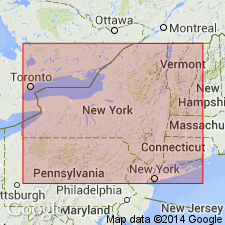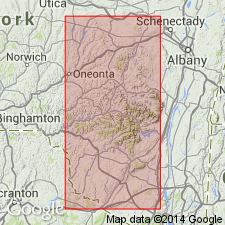
- Usage in publication:
-
- Dayville limestone
- Modifications:
-
- Original reference
- Dominant lithology:
-
- [Limestone]
- AAPG geologic province:
-
- Appalachian basin
Summary:
[Dayville limestone of Helderberg group.] When traced westward from the Helderbergs, the Coeymans formation thickens to nearly 100 feet at Cherry Valley. Slightly further west, this greatly thickened Coeymans splits into three parts. Lower part, for which name Dayville limestone is proposed, grades laterally into Olney limestone of Syracuse area. Present in central New York. Age is Early Devonian.
Type locality and derivation of name not stated. [Probably Dayville area, Herkimer Co., central NY.]
[On p. 1055 (USGS Bull. 1200), Geologic name header is Dayville Member (of Coeymans Limestone); is in bold face, indicating usage adopted by the USGS.]
Source: US geologic names lexicon (USGS Bull. 1200, p. 1055).

- Usage in publication:
-
- Dayville Member*
- Modifications:
-
- Overview
- AAPG geologic province:
-
- Appalachian basin
Summary:
Pg. B8-B9 (fig. 2), B14-15, 16. Dayville Member of Coeymans Limestone of Helderberg Group. Present in Dayville and Jordanville areas, Herkimer County, New York; grades laterally into Olney Member of Manlius Limestone to the west (Syracuse-Manlius area, Onondaga County, New York). Occurs above Thacher Member and below Elmwood Member (waterlimes), both of Manlius Limestone. Rickard (1962, New York State Mus. Bull., no. 386, 157 p.) traced the members of the Manlius Limestone eastward to the vicinity of Vanhornesville, New York, and demonstrated that the decrease in thickness of the Manlius is due to interfingering with the Coeymans Limestone, rather than an unconformity as believed by earlier workers. He concludes (Rickard, 1962, p. 117-119) that the Silurian-Devonian boundary is below the Manlius Limestone, and that the Manlius belongs with the Helderberg Group and is Early Devonian in age. Rickard named the crinoidal limestone of Coeymans lithology which occurs beneath the Clark Reservation and Elmwood Members of the Manlius at Dayville and Jordanville the Dayville Member of the Coeymans and applied the name Deansboro Member of the Coeymans to the crinoidal limestone overlying the Jamesville Member of the Manlius. He has also named a new member of the Manlius, the Thacher, which is exposed in the Helderberg escarpment. In his opinion (1962, p. 93-97), the Manlius Limestone represents a lithified calcareous ooze, whereas the Coeymans Limestone is a lime sand, and the two facies interfinger. Comparison of faunas (e.g., brachiopods and ostracodes) of the Dayville Member of Coeymans (Devonian), type Manlius, and Cobleskill Limestone (Silurian) shows that the type Manlius is closely related to the Coeymans faunally and is entirely distinct from the Cobleskill. Thus, Rickard's conclusion that the Manlius belongs in the Helderberg Group and should be considered Lower Devonian seems entirely justified. Present in Dayville and Jordanville areas, Herkimer County, New York. Report includes nomenclature history, correlation chart, faunal lists. Lower Devonian Dayville Member of Coeymans Limestone of Helderberg Group adopted by the USGS.
Source: Publication; Changes in stratigraphic nomenclature, 1963 (USGS Bull. 1194-A, p. A12).
For more information, please contact Nancy Stamm, Geologic Names Committee Secretary.
Asterisk (*) indicates published by U.S. Geological Survey authors.
"No current usage" (†) implies that a name has been abandoned or has fallen into disuse. Former usage and, if known, replacement name given in parentheses ( ).
Slash (/) indicates name conflicts with nomenclatural guidelines (CSN, 1933; ACSN, 1961, 1970; NACSN, 1983, 2005, 2021). May be explained within brackets ([ ]).

